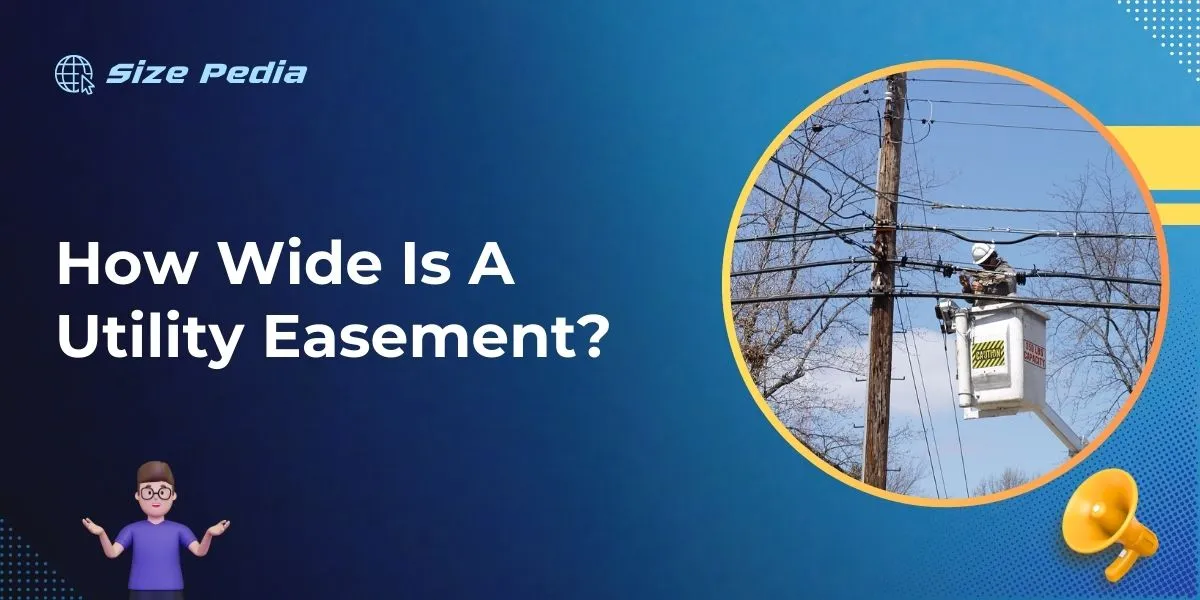A utility easement typically ranges from 5 to 50 feet wide. The specific width depends on the utility type and local regulations.
Understanding utility easements is crucial for homeowners and developers as they navigate property planning and improvement projects.
Utility easements grant service providers the right to use or access parts of private property for maintenance or service lines installation, such as electricity, water, and sewer connections.
The exact measurements of these strips of land can vary based on the needs, such as accommodating larger equipment or ensuring safety and maintenance access.
Each local government or municipality may have different standards that affect easement width, making it important to check local ordinances and property deeds for precise information.
Properly managing utility easements can prevent legal disputes and ensure that essential services remain accessible to communities.

Introduction To Utility Easements
Utility easements are integral to any urban or suburban landscape. Think of them as invisible pathways. These paths allow utilities to reach your home. They run through private and public property. Easements provide essential services such as water, electricity, and internet.
Purpose Of Utility Easements
Easements have a clear purpose. They allow utility companies access to maintain, repair, or upgrade their infrastructure. This access is a right that stays with the property. It assures service reach for everyone.
Common Types Of Utility Easements
- Electrical Easements: For power lines and transformers.
- Sewer Easements: For underground sewage lines.
- Water Easements: For water supply systems.
- Communication Easements: For internet and cable services.
Determining The Width Of Utility Easements
Determining the Width of Utility Easements often seems complex. But it is critical for planning and development. The width can affect building plans and land use. Understanding this width is essential for homeowners and developers alike.
Standard Width Measurements
Standard widths for utility easements can vary. They depend on local regulations and the utility type. To start, here’s a basic guide:
- Electrical lines: Typically 10 to 20 feet
- Pipelines: Usually 20 to 100 feet
- Sewer and water lines: Often 10 to 15 feet
Factors Influencing Easement Width
Different elements can alter an easement’s standard width. Let’s look at these factors:
- Utility type: Gas lines may need more space than water lines.
- Land use: Residential areas might have narrower easements than industrial zones.
- Regulations: Local laws can greatly impact easement sizes.
A precise easement width comes from detailed plans. You might need a survey or to look at your property deed. For the most accurate information, consult local authorities or a professional surveyor.
Legal Framework Surrounding Easements

Easements are legal rights to use someone else’s land for a specific purpose. Understanding the legal groundwork for these rights is crucial for property owners and utility companies alike.
Property Rights And Easements
Property rights give landowners control over their land. Easements may allow others access for specific uses. Easements can be for utilities, access, or even drainage.
The legal creation of easements involves:
- Granting Deeds – official documents transferring rights.
- Wills – easements given through inheritance.
- Prescription – rights after long-term use.
Easements stay with the property even if it sells. This is crucial for both current and future property owners to know.
Regulations Governing Easement Dimensions
The width of an easement often depends on its use. Utility easements have specific guidelines for width.
| Type of Utility | Typical Easement Width |
| Electric Lines | 10-20 feet |
| Water/Sewer Pipes | 15-25 feet |
| Natural Gas Pipes | 12-20 feet |
Local and state laws define these regulations. Different areas may have unique requirements. Always check with local authorities for specific dimensions.
Case Studies Of Utility Easement Widths
Understanding utility easement widths can seem daunting. Yet, real-world examples shed light on typical scenarios. Homeowners and business operators benefit from these insights.
They aid in planning and maintaining properties with easements. Below, explore varied case studies featuring utility easements on different property types.
Residential Property Easement Examples
Consider three residential settings with distinct easement widths:
- Suburban Home: A single-family residence shared a 10-foot wide easement. It allowed electric line access.
- Rural Farmstead: This property had a wider, 30-foot easement. It accommodated a gas pipeline.
- Urban Townhouse: A townhouse complex featured a 15-foot easement. It was for underground water services.
Each case reflects necessities tied to location and utility type.
Commercial Property Easement Scenarios
Commercial easements often require more space. Take these cases as examples:
| Property Type | Utility | Easement Width |
| Retail Center | Electric and telecom | 20 feet |
| Industrial Park | Sewage and water | 25 feet |
| Office Complex | High-capacity electric lines | 40 feet |
These examples show diverse needs based on commercial functions.
Navigating Utility Easement Issues

Navigating utility easement issues often requires a clear understanding of how wide an easement is. Easements grant service providers the right to use a section of land for utility work.
Still, the actual width can lead to confusion and conflict. Homeowners and land developers must recognize the importance of easements to avoid legal disputes and ensure proper land use.
When Easement Widths Are Disputed
Easement width disputes arise when the recorded easement is unclear or parties disagree on interpretation. Here’s a closer look at managing these disputes:
- Review the deed: Check the legal description of the easement on property records.
- Seek clarity: If unclear, consult with a land surveyor to determine precise boundaries.
- Legal recourse: In unresolved disputes, legal intervention may become necessary.
Professional Advice For Easement Concerns
Professional advice is crucial for navigating easement concerns effectively. Below is essential guidance:
- Consult with experts: Land surveyors and real estate attorneys can provide valuable insights.
- Understand utility needs: Grasping easement requirements for utilities like water, gas, or electric lines aids in compliance.
- Maintain records: Keeping detailed easement documents helps resolve future issues quickly.
Conclusion And Best Practices
Understanding utility easement width is crucial. It affects property use and maintenance. Knowing the specifics can avoid legal issues and promote effective land use. Below we explore best practices for easement management.
Maintaining Easement Integrity
Keeping utility easements clear is necessary. It ensures utility companies can access and maintain their infrastructure.
- Regularly inspect easements.
- Remove obstructions like trees or structures.
- Communicate with utility providers for guidelines.
Landowner awareness is vital. Know where easements are. Follow local regulations to maintain them. This practice prevents utility disruptions.
Planning For Future Utility Needs
Anticipate utility expansion. Technology and populations grow. Utilities may need wider easements.
- Consult with planners on future public utility needs.
- Consider potential easement alterations in property plans.
- Coordinate with utility companies for long-term strategies.
Protect property rights and plan for growth. Balancing current and future needs leads to smart land development.
FAQs About How Wide Is A Utility Easement
How Wide Are Most Easements?
Easement widths vary widely, typically ranging from 3 to 30 feet, depending on their use and local regulations.
What Type Of Easement Is Commonly Used By Utility Companies?
Utility companies often use an easement known as a right-of-way. This easement allows them to access land to install and maintain utility lines.
Can I Refuse A Utility Easement In Tennessee?
In Tennessee, you can refuse a utility easement, but utilities may obtain it through eminent domain if necessary for public interest.
Can I Refuse A Utility Easement In California?
In California, you can refuse a utility easement, but utilities may obtain an easement by condemnation if it’s necessary for public service.
Conclusion
Understanding the breadth of a utility easement is essential for property planning and development.
Every easement varies in size, often determined by local regulations and the utility type involved. It’s crucial to consult with local authorities or a legal advisor to navigate these specifications.
Remember, clear knowledge of easements can save time and avoid legal complications down the road.
Resources:
1. https://www.anaheim.net/5550/Utility-Easements
